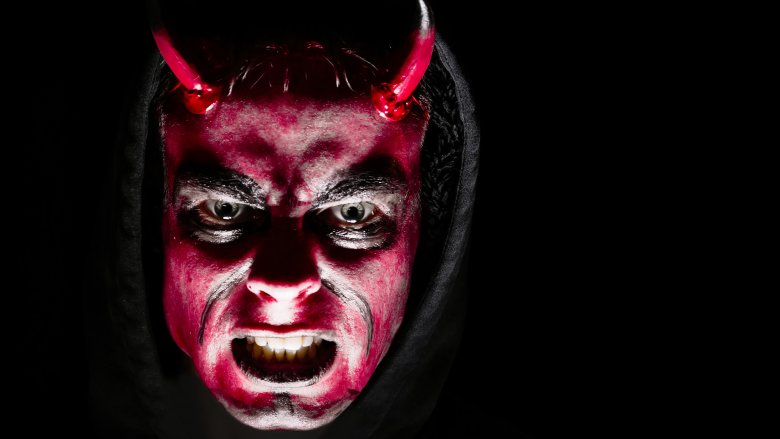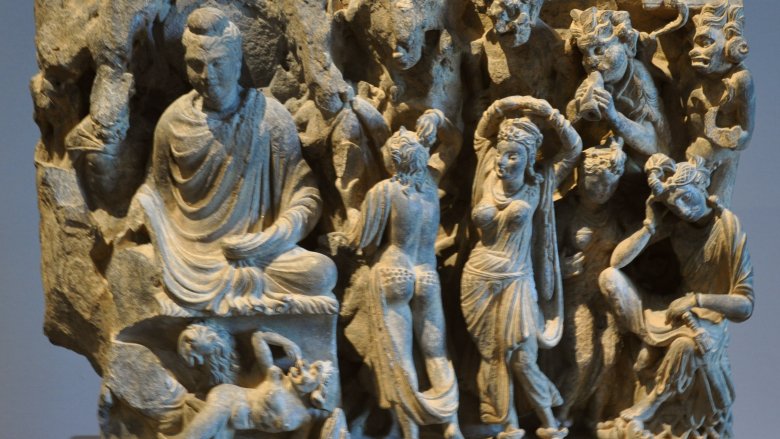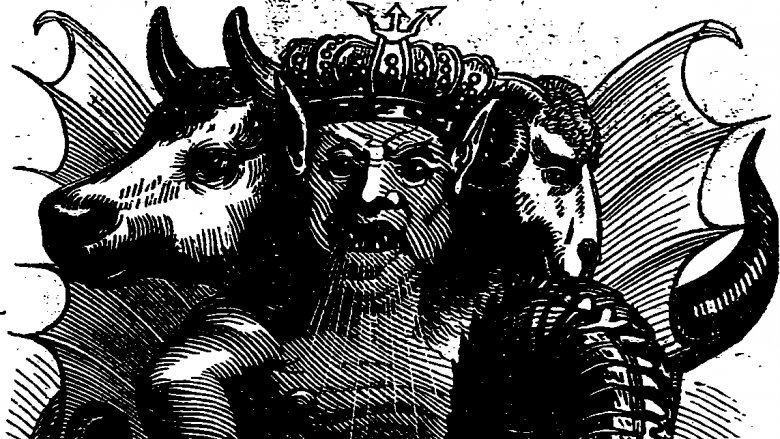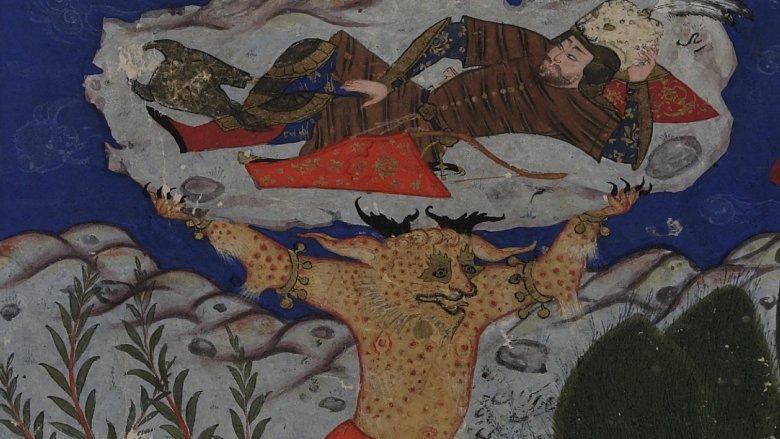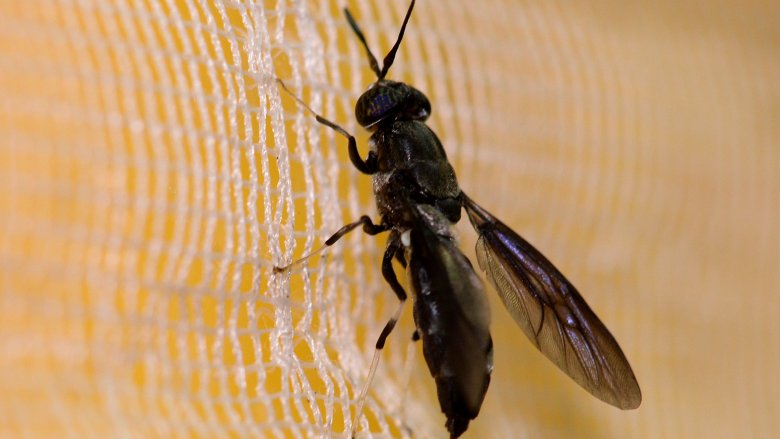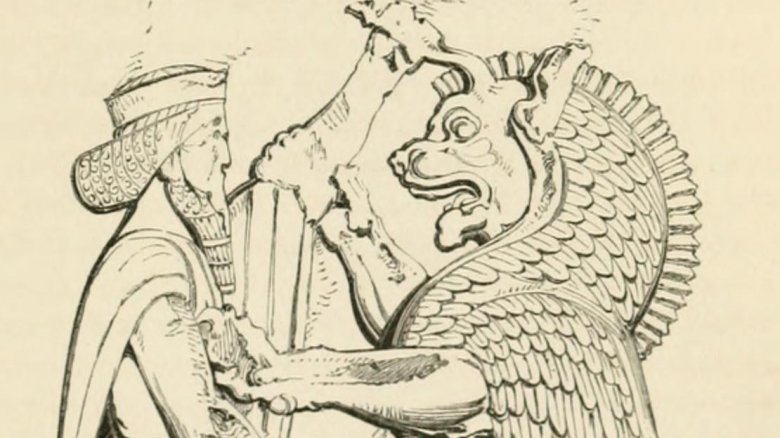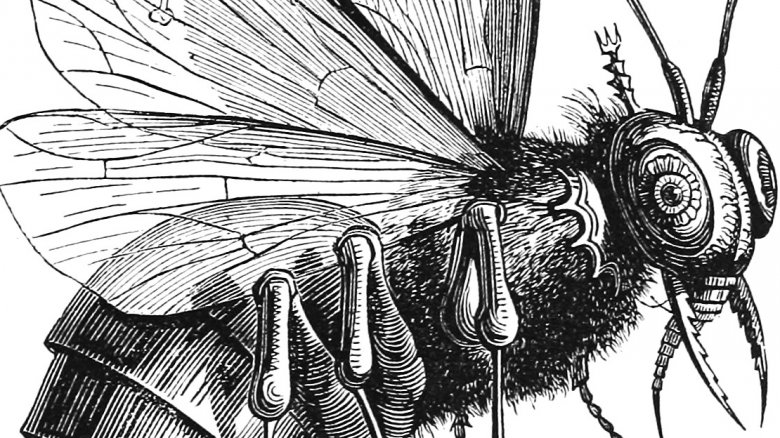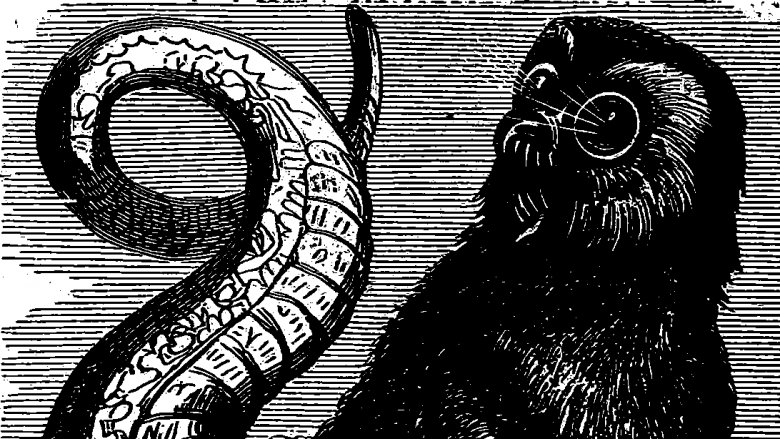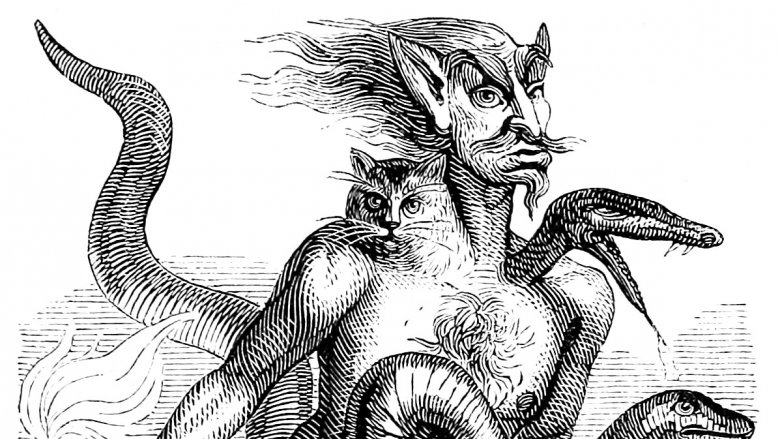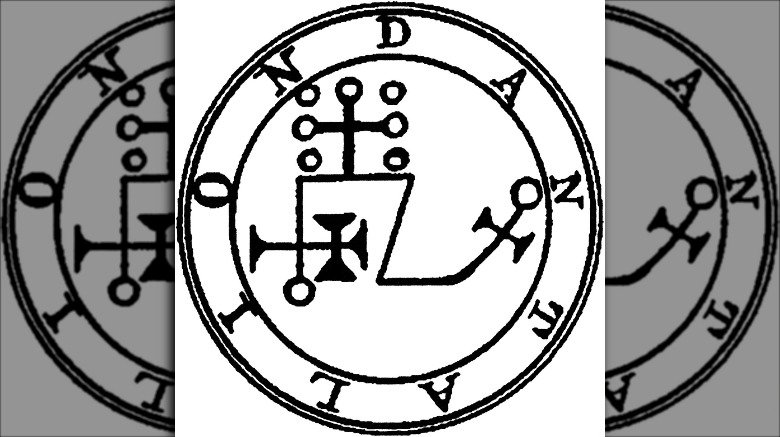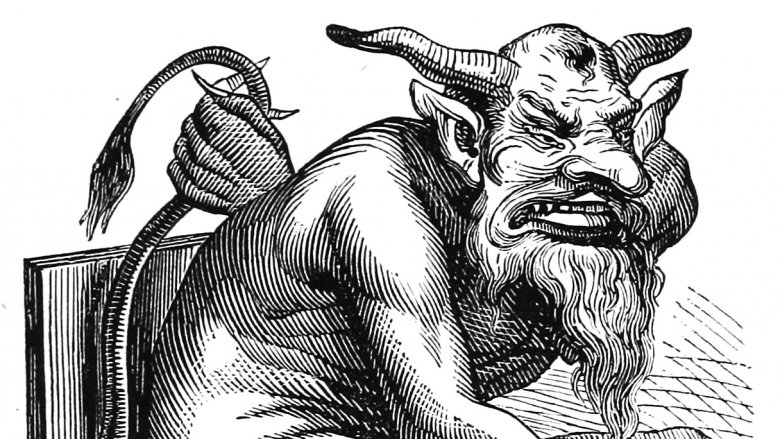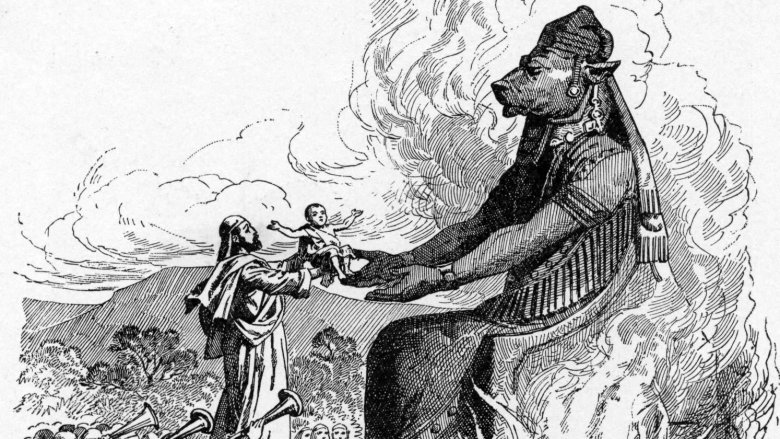The Creepiest Demons Described In Religious Texts
These days, most people's concept of demons probably stems from an appreciation of shows like Supernatural or the semi-vague descriptions communicated by televangelists, but a significant amount of human history has been flavored by very specific beliefs in evil spirits. Through folklore and word of mouth, these creatures have haunted different cultures, sometimes as malevolent forces for chaos, and other times as mythical antiheroes, putting a violent end to those who fall short of a society's moral standards.
Maybe the most gripping accounts of demons come from official religious texts that take the beasts from the domain of rhetoric into a group's canon of spiritual beliefs. There's just something super scary about a faith telling its followers that, part and parcel with a hope for a better world, there comes the promise of a much more terrifying one. Let's take a look at some of the most deplorable monsters from religious texts across human history.
Mara is the embodiment of evil
If you've never heard of this peach, here's a quick crash course on the Buddhist demon known as Mara. He's evil, no two ways about it. Mara is deception, trickery, and dishonesty incarnate. The fourth largest religion in the world is based, in some small part, around the fact that nobody likes Mara. So if nothing else, at least now you've got a source to link to if you know someone named Mara that you don't like.
The Buddhist scriptures known as the Samyutta Nikaya tell the story of Mara attempting to sway Gautama Buddha on his path to enlightenment by using a number of underhanded methods. There's the basic skullduggery, like rubbing bad news about the Buddha's family in his face, and more supernatural horrors like starting terrifying storms made of rocks and darkness and summoning a horde of hellish monstrosities. In a particularly dastardly move, Mara is said to have sent his three beautiful daughters, the personifications of thirst, passion, and discontentment, to do sort of a magical burlesque show for the great teacher and try to throw him off his guard.
In the end, Mara winds up actually getting converted to Buddhism, according to "The Legend and Cult of Upagupta," by John S. Strong. It's a story powerful and important enough that you've probably seen depictions of it and not even been aware. Statues and paintings of the Buddha in which he's sitting cross-legged and holding his fingers to the ground are depicting the moment of his calling on the Earth to witness his defeat of the tempter.
Asmodeus is the proto-slasher
We've seen it a thousand times. The amorous couple in the horror movie is just about to get busy when, shockingly, the slasher shuffles out of the darkness and gets to murderizing. It's a trope, and as it turns out, it's older than you think.
The demon known as Asmodeus appears in the Book of Tobit, a Judeo-Christian book of the Bible that's either religious canon or apocrypha, depending on which branch of Christianity you subscribe to. Asmodeus is said to be the "worst of the demons." He doesn't hesitate to kill, and he has what has to be the lamest, most specific Achilles heel in the history of monsters.
In the Book of Tobit, there's a young woman named Sarah who would very much like to be married. She becomes engaged, gets married, and then right before the sweet, sweet consummating, Asmodeus shows up and kills her husband. What might seem like a fluke quickly becomes a trend, as this happens to Sarah a total of seven times.
On lucky number eight, Sarah, who must have been an amazing conversationalist for this many guys to roll those dice, marries a guy named Tobias, who the archangel Raphael gives the scoop on how to beat Asmodeus. The demon appears on the wedding night, and Tobias tosses a fish's heart and liver onto some coals, causing smoke that triggers Asmodeus' asthma or something. Asmodeus scampers off, and Raphael tracks him down, ties him up, and strangles him.
Zoroastrian religious texts are full of creepy daevas
Not so much one specific character, but rather an entire race of what scholars refer to as "real jerks," the daevas spring from Zoroastrianism, and they get up to some shady business. If you're unfamiliar, Zoroastrianism is one of the oldest religions still being practiced today. How old is it? Old enough that nobody's sure exactly how old it is. So like, Dick Van Dyke old.
Traditionally, daevas are thought to be the creations of Ahriman, an antagonistic and equally powerful counterpart to the benevolent creator. In one of their religious texts, the Gathas, daevas are described as rejected gods with an affinity for evil who, for whatever reason, still hold sway with some followers. One of their chief character traits is an inability to discern truth from lies, making them at least psychologically adjacent and possibly directly related to most roommates you're likely to meet on Craigslist.
In later books, daevas make the leap from ambiguously evil to straight-up dangerous, with entire sections of a book written on how to combat them. The book, the Vendidad, or "the law against demons," describes purification rituals that will stave off the beasts, some of which involve a personal rub down with bull urine, which should give you an idea of just how badly people wanted these things gone.
Nasu is one nauseating demon
There's a lot of body horror that goes into the story of Nasu, with elements of John Carpenter and Candyman springing to mind. The point is, this is nobody's ideal dinner guest.
A couple of Zoroastrian demons were assigned dominion over a particular field of unpleasantness. While Aeshma was the spirit of fury, Nasu was the patron demon of death and decay. She had a nasty habit of turning into a fly and taking up residence in the bodies of the recently deceased. After that, she'd start the process of decomposing the corpse.
And it wasn't just the dead who had to worry about her. A strict set of guidelines were put in place to ensure that anyone handling a dead body wouldn't be tainted by Nasu's sway. It was important that nobody handle the deceased on their own, since Nasu, in bug form, would climb out of the body's mouth or, you know, other bits, and infect the poor son of a gun. At that point, there would be no way of cleansing the still-living victim of Nasu, and they would have to live in an enclosure far removed from everyone else, where they would live out their life until they were elderly and then be beheaded. Tough but fair.
Ahriman is the demon ruining the world
We can all agree that if evil has one common trait across all cultures, it's bureaucracy. Every Hell needs a Satan, every Foot Clan needs a Shredder. To the Zorastrians, the final boss in the demon level is Ahriman.
Due in part to the fact that a lot of ancient Zoroastrian texts have gone missing over thousands of years, Ahriman's origins are a little murky, but some stories say that he's the son of Zuvan, the creator, who said that the first born of his twins would rule the world. Knowing an entrance line when he heard one, Ahriman tore his way out of the womb, chestburster-style, and rules being rules, took his place as the guy in charge of everything. The takeaway here is that, Mercury's retrograde notwithstanding, this is why the world is such a drag. It's being ruled over by a merciless lord of evil. There's a joke about politics to be made here, but let's leave that be for now.
Also on the list of Ahriman's professional accomplishments is his creation of 99,999 diseases, which, if nothing else, is hellish torture for OCD completionists to look at. The good news is that, eventually, Ahriman's more evenly tempered brother will take back control, and everything will be okay again.
Any day now. No rush. We've got time.
Beelzebub is a power player
For all of the buzz about demons that you get in Christianity, they're pretty thin on the ground in the Bible itself. There's Abaddon in Revelations, an upper management type in Hell. And then there's Legion, a collection of demons that Jesus parlays with in Mark, dropping them into the bodies of pigs and then watching them commit mass suicide.
And then there's Beelzebub, a demon with roots in old Philistine religions. His name comes up in the Bible a few times in the Gospels of Matthew and Luke, and he may be a stand in for Satan, but another translation of "Beelzebub" is "lord of the flies." John Milton's theory, described in Paradise Lost, is that he's a lieutenant of Hell, second in power only to Satan, which is what folks in the industry refer to as "resumé gold."
The starring role of Beelzebub's career is probably his part in the Salem Witch Trials, in which he was blamed for inhabiting the bodies of the accused. For anyone riding the fence on whether or not there was any real justice to be had there, it's worth looking at the writings of Cotton Mather, a Puritan minister in the area at the time. In his work Of Beelzebub And His Plot, Mather wrote, "That there is a devil is a thing doubted by none but such as are under the influences of the devil," which is very much the "when did you stop beating your wife" of logic traps used to execute innocent people.
Aamon's creepy transition into weirdness
Aamon, pronounced like it would be in that Key & Peele sketch (no, not really), is a pretty bad dude in the demonic hierarchy. This guy commands 40 legions of evil spirits. That's a whole lot of demons doing your dirty work. However, he takes a step down in the dignity department when reimagined as a marquis of Hell in the Ars Goetia section of the 17th-century grimoire, The Lesser Keys of Solomon. There, he's described as, physically speaking, sort of a trash can fire.
The Lesser Keys of Solomon calls Aamon (or Amon, or several other spellings; demons aren't great about consistency) "great in power and most strong," then goes into a visual description that's akin to the way a troubled 8-year-old might describe a monster they were making up on the spot. He's said to have the shape of a wolf, which is pretty straightforward. Then the book tacks on a serpent's tail for good measure and a mouth "vomiting fleames [sic] of fire."
No doubt understanding the importance of a good first impression, Aamon can take another shape, too. When "at ye command of ye Magician," he turns into a man. Just a regular old man. With a raven's head. And dog teeth. A lot of these guys had sort of a "hat on a hat" thing happening.
Aim is going to burn it all down
Aim, not to be confused with villains from Marvel or the AOL chat service from 20 years ago, is another of the demons described in The Lesser Keys of Solomon. A duke of Hell, he's one more in the great satanic conga line of "so weird as to be disturbing" servants of Lucifer.
The closest thing to a flattering remark that can be made about Aim's physicality is sort of a backhanded compliment. One of his heads is supposed to be a real looker. The human one. And sure, he's got a couple of stars tattooed on that noggin, but it still probably looks a lot more charming than the other two heads — one of a viper and the other either a cat or a calf, depending on the translation. He rides a snake, which is objectively metal, and is apparently able to "maketh one witty."
His main job, though, is setting things on fire. If there's one thing he loves to do, it's that. He's said to carry a "fire brand" in his hand, so as to be able to burn cities, castles, and "great places" to the ground.
Dantalion is a demon with mind control powers
The 71st demon described in The Lesser Keys of Solomon is Dantalion, who, along with being voted "most likely to grow up to be a musketeer based solely on his name" in his high school yearbook, is a great duke of Hell. He's said to command 36 legions of spirits, or roughly 180,000 of the beasties by classical Roman interpretation.
The image of Dantalion is fascinatingly upsetting. He's said to have "the form of man with many countenances, all men and women's faces." It's a little hazy whether he's meant to have multiple faces at once or the ability to change his appearance, but that's not even the creepiest thing about him.
If you're a fan of free will, Dantalion is not your dude. He supposedly has the ability to control people's minds. Ars Goetia tells us that "he knoweth ye Thoughts of all men and women, and can change them at his will." Even more frightening, he's one of several demons in the book that's said to be able to "cause love," making him, at best, problematic in any social climate.
The Belphegor movement
Belphegor began life in the Torah as Baal of Peor, a Moabite god worshiped by Israelites who were drawn in by seductive ladies and so on. What follows is a little of that Old Testament God wrath that you just don't see anymore, with a five-figure death toll and plenty of weirdness.
Over the course of the next several centuries, Baal of Peor made an astonishing transformation akin to whatever the opposite of what happens on Queer Eye is. He went from being a respected deity to Belphegor, a demon who likes to ensnare potential victims by disguising himself as a little girl. Also, and not to bury the lede, but he's a poop monster. Yeah, he's a demon who accepts poop as an offering. Go ahead and take some time to digest that. Belphegor is more than happy to wait.
Okay, so as we were saying, Belphegor is a poop demon. Not in the Golgothan-from-the-movie-Dogma sense, but more like in a Robin Williams-in-The Fisher King way. He just really appreciates a good bowel movement. Sure, he's been associated with other things, like lust, laziness, and the ability to grant wealth, but in the same way that the name Richard Gere probably makes you think "gerbil" before you think "Golden Globe winner," Belphegor will always be a poop demon first in our hearts.
Moloch is a demon who loves his baby back ribs
The demon lord known as Moloch started strong in the grossness department and just seems to have gotten more horrific with every successive description. In the Bible, he's presented as another in a long line of heathen gods. The Book of Leviticus seems especially worried about the guy, saying that anyone who gives Moloch their children will be rocked to sleep (aka "stoned to death").
There seems to be good reason for concern. Moloch is big into chowing down on kids, a habit that has added implied grossness when you find out that he had a cow's head. It's just, if you know how cows eat, the visuals get exponentially more horrific.
Moloch shifted and warped from the time of Moses into a feared, high-level lord of Hell. In the second book of Paradise Lost, he gives an enthusiastic speech to the members of the parliament of the underworld, encouraging them to go to war with Heaven immediately. In the first book, we're given a description of his work attire. He's smeared with blood from human sacrifices and the tears of mournful parents. So he's not just a baby killer, but he's also a messy eater ... and one of the most terrifying demons from any religious text.
